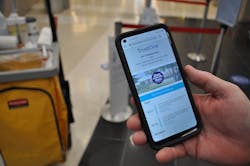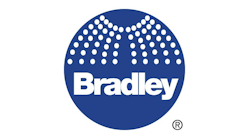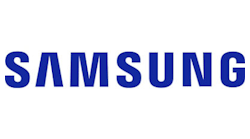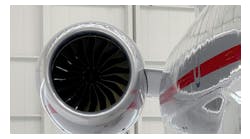A Clean and Clear Future
Albany International Airport (ALB) has been proactive addressing cleaning and sanitizing efforts throughout the pandemic with an emphasis on technology.
ALB CEO Phil Calderone said the airport installed fresh air filtration systems and implemented intensive sanitization protocols as well. It’s using UV lighting to sanitize touch surfaces and other protocols one of the first in the nation to require masks and social distancing along with putting up barriers at contact points throughout the terminal.
“It’s an interesting time to say the least,” Calderone said. “It’s challenging for all the obvious reasons, but while we’re putting into place protocol and safety measures so the public feels safe in the airport, I’m also encouraging folks to not travel.”
Calderone put together a COVID Task Force in February to look at the airport’s preparedness and determine how technology can be part of its master plan. GE was invited along with other key health and emergency preparedness members of the community, local aviation officials and airport tenants.
“What could we do to ensure travelers that not only the experience of being on an aircraft, but being in the airport terminal was as safe as possible for them was our primary focus and concern,” he said.
GE brought in partners from its aviation division in Texas and they focused on block chain technology. This became the Wellness Trace app, which ALB put into service in November.
The app allows airports and airlines to track COVID-19 screening for both passengers and employees and set protocols for tracking the cleaning of objects in the airport or aboard aircraft to ensure they are regularly disinfected. It offers the public to provide real time feedback into the cleanliness of their travel experience.
QR codes are placed at areas that see the most use from the public in the airport. This includes ticket counters, restrooms, baggage claim areas, concession areas, lounges, gate areas and the business center. Travelers have access to real time cleaning information so they know when an area was last cleaned and sanitized so they know efforts are taking place to protect them.
“It’s important to make individuals who come into our terminal feel that the environment they’re in is safe,” Calderone said. “This is a validation of that. It’s taking blockchain technology, incorporating it into the wellness app and creating a technology that allows folks using QR codes and smart devices to scan those codes…and fine out in real time the last time those areas were cleaned and sanitized.”
Andrew Coleman, general manager, aviation software at GE Digital, said the company transitioned its usage of blockchain for aircraft parts traceability into tracking cleanliness.
“I heard this analogy that this season, there are some things that are going to be like a rubber band where we pull them and they’re going to go back to the way they were and there are somethings that are going to be like plastic where we’re going to bend it and it’s never going back to the way it was,” he said. “We truly felt that cleanliness, given the technology we have and give how rudimentary it is in airports today, something we could really move the needle on.”
GE worked with the airport to find the areas travelers are most concerned with in terms of cleanliness. Coleman said the company also surveyed its frequent traveling employees to get their perspective for additional input.
Albany wanted to track who cleaned an area, what cleaning action they performed and what cleaners they used. Coleman said it allows management to track its operations and it also assists tracking cleaning product usage to assist in reordering. Blockchain ensures data can’t be changed or faked, giving both management and the public confidence in the data.
Calderone said it's a great management system for ALB. It sends leadership notices when an area has been cleaned so they can track efforts and make sure efforts are meeting their goals. The public gets validation of those efforts by retrieving the date themselves.
“I was incredibly pleased that there was such buy-in from our staff and embracing being part of this and being proud of being part of a new, cutting-edge technology that was being introduced at the airport,” Calderone said.
Calderone said constant communication is important is key when talking with technology providers for a solution. GE had a clear understanding of the airport’s goals and ALB understood what the company’s capabilities were.
“Reaching out to resources that you may have in your own community and making folks aware of what your challenges are and how they can assist in those challenges yields results and surprises that can help us get through this challenge,” Calderone said. “That’s precisely not only what happened with GE, but with out relationship with SUNY Upstate.”
The airport is being recognized for all its efforts to protect travelers during the pandemic. Both the Global Bio Risk Council (GBAC) and Airports Council International (ACI) have given ALB accreditation for the safety and health protocols it put in place.
ALB is taking further steps to protect passengers with its recently implemented COVID testing system. SUNY Upstate and Quadrent Biosciences developed a saliva-based testing system that was first implemented in a commercial setting at ALB. Calderone said it’s one of the most accurate testing systems in the world.
“Cleanliness, once you introduce it to the general public, isn’t going away,” Coleman said. “People are going to search on it, they’re going to travel on it and they’re going to buy on it.”
Bathrooms are Forever Changed
Jon Dommisse, director of global strategy and corporate development for Bradley Corp., said 91 percent of respondents to the company’s annual Healthy Handwashing survey want touch-free fixtures in public restrooms. “That’s a pretty clear edict of what the expectation is,” he said.
About 76 percent of those surveyed reported a negative restroom experience in 2020. Dommisse said people are a lot more cognizant and careful in public bathrooms because of the pandemic.
“How the iPod changed music and 9/11 changed air travel, I think COVID will forever change public bathroom design in airports and any non-residential application,” he said.
He said there will be more handwashing stations not located within a restroom in facilities like airports. These could be placed just outside the restrooms, within hallways or even located near food centers.
“Almost every non-residential/commercial application is rapidly moving toward at least hand sanitizers dispensers being located everywhere in a public building,” he said. “Some of those applications will say the hand sanitation is fine, but others are going to take it to the next level and put in one or two actual hand washing stations to take traffic pressure off the washroom itself.
Architects are being charged with including individual containment options for commercial bathrooms, Dommisse said. The demand is to to meet the needs now, but they don’t expect it to go away once the pandemic is over.
“This is in direct contrast to what the edicts have been to designers and manufacturers like us for space maximization, maximizing traffic flow and sustainability,” he said. “Those are all taking a back seat now to make sure that inclusive individual containment is the No. 1 factor.”
Dommisse said airports can purchase hand sanitizer stations now for a triage solution to meeting public safety needs. As airports look to permanent solutions for the future, he said there has been an expansion of touchless faucet products. “We could very well be seeing the death of traditional faucets in the public bathroom,” he said.
Metered, touch-free faucets will provide additional savings on water usage as well. Many also include data for operations such as usage, which Dommisse said can save on maintenance time.
Airports should also look at how to keep bathrooms clean, well-maintained and stocked in addition to the safety. There also needs to be a very acute awareness of social distancing parameters.
“Water on floors, water on countertops, where it used to be just irritating and visually unpleasant, now it almost looks like it’s a poison,” he said. “What’s in that water? Who did that water come from? It’s a very heightened sensitivity to it.”
Technology Meets New Demands
The Cincinnati/Northern Kentucky International Airport (CVG) is using bluetooth signaling off its restrooms to determine how many customers have gone into a facility. A threshold is established for housekeeping staff to clean the restrooms after so many people enter.
Losant, a Cincinnati-based start-up, is the provider of CVG’s sensor tech. The airport connected the data flows and algorithms to wearable tech provided by another local start-up, TaskWatch. The watches location ID supports specific alerts being directed to the nearest male or female housekeeper to attend to the gender-specific bathroom in need of attention.
“There’s a myriad of capabilities within the watch, but ultimately, they support driving quality assurances for our customers and performance metrics by staff,” Brian Cobb, chief innovation officer for CVG said.
Housekeepers wear Samsung watches that alert them when the threshold is hit.
Staff clean a restroom after 50 people use it. Prior to COVID-19, it was 100. Adam Daniel, vice president of enterprise solutions for Losant, said the system was initially designed and implemented solely on the basis of improved efficiency for housekeeping crews. Since the pandemic started to play out, the configuration in place gave the airport the ability to adjust the thresholds for cleaning, it helps limit exposure to the cleaning crews and it also alerts staff if people enter areas of the terminal that are closed due to low traffic. “They may put barriers in front of bathrooms, but we were able to detect when people snuck in and gave them an indication they needed to clean an area that wasn’t expect,” he said.
CVG is in the process of integrating sensors on its Georgia-Pacific fixtures. The sensors are provided by GP and can be integrated into Losant and TaskWatch platforms via api. Cobb said this enables activity-based decisions down to specific stalls, sinks, towel units, etc. on a macro level and preventative maintenance needs on a micro-level. On financial and sustainability levels, the technology reduces the amount of wasted paper that may have previously been discarded; housekeeping staff replacing a partially used roll/stack/package with new to prevent running out before they cycle back.
“Well past COVID, now you’re talking about asset management,” he said. “We can all understand that the bathroom that gets 1,000 visits per day needs more maintenance than the one getting 200 per day, so it helps create strategy well past COVID.”
Since the pandemic started, there’s more discussion on doing a directional count with the system Daniel said, so they can enforce social distancing easier.
“Typically people are looking at ROI or gaining efficiencies with solutions around IoT and how can we reduce cost or increase the productivity,” he said. “Instead of just ROI, people are thinking about safety more.”
CVG is also testing a new paint in an employee bathroom. The paint is mixed with graphine and limestone and the molecular makeup is like barbwire to COVID – it shreds the virus and neutralizes it. It also shreds bacteria in addition to viruses, which not only helps from a health perspective but also odor prevention.







